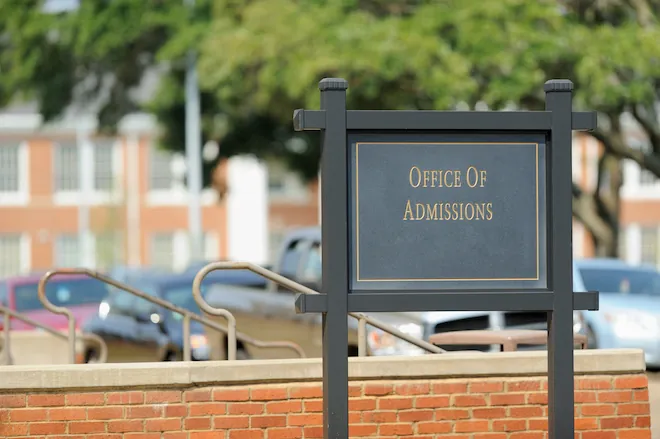
It’s hard to believe any school with an acceptance rate under 6% could actually get harder to get into. But in 2022, that’s exactly what happened at Cornell.
The Dyson School of Applied Economics & Management in Ithaca, New York, was the most selective business in Poets&Quants‘ 2022 undergraduate ranking, at a miserly 5.4% acceptance rate for the entering class of 2021. That earned the Ivy League school special attention as the toughest business program to get into among a crowd that included Wharton, NYU, USC, Michigan, and Georgetown.
“Dyson students,” Dean Jinhua Zhao told P&Q last year, “apply ideas and create solutions that extend beyond individual gain. With an acceptance rate of 5.4%, we take time to evaluate and appreciate students for who they are and how they will contribute to our diverse community.”
If 5.4% got Cornell Dyson a well-curated student body, 4.17% — the acceptance rate Dyson reports for the Class of 2026 entering last fall — must make it the Cooperstown of B-schools. Of 5,680 applications, Dyson admitted just 237; of those, only 163 actually enrolled, boosting the school’s total current enrollment to just over 900.
8 B-SCHOOLS WITH BELOW 10% ACCEPTANCE RATES

Cornell Dean Jinhua Zhao: “Dyson graduates have strong business skills, a deep understanding of how business decisions impact society, and understand how to use their business skills for the greater good”
Of 92 undergraduate business schools in the 2023 Poets&Quants ranking, Cornell Dyson, ranked No. 6 overall, is one of only two schools with a rate lower than 6%. Northeastern University’s D’Amore-McKim School of Business in Boston, at 5.73%, is the other.
It’s rarefied air in upstate New York. Eighty-two percent of Cornell’s latest class graduated in the top 10% of their high school class, up from 75% in 2021; in past years as many as 20% have been National Merit Scholars. The class also boasts a 1520 SAT average and 34 ACT average — all of which helps to explain why Cornell jumped 10 spots in this year’s ranking.
After Northeastern, rounding out the five hardest schools to get into are No. 3 Wharton, at 6.3%; No. 7 New York Stern, at 6.6%, and No. 46 Carnegie Mellon Tepper, at 8.62%. In all, eight schools had rates below 10% (see table below), up from five, in a year in which the difficulty getting into top schools mostly increased — with a few notable exceptions.
ONE B-SCHOOL SAW ITS ACCEPTANCE RATE DECLINE BY 76%
Of 92 ranked schools, just 29 saw their acceptance rate increase between 2021 and 2022, meaning it got easier to get admitted, and 58 saw their rate drop. That’s basically a reversal of the trend from 2020 to 2021, when 38 schools grew their acceptance rates; it’s also a final reversal of the explosion in rates we saw during the pandemic intake of 2020 (see the next pages for four-year tables of the rates at all the ranked schools).
Notable declines in acceptance rate occurred at No. 24-ranked University of Washington Foster School of Business, which dropped to 20.98% from 39.08%; at No. 12 University of Illinois at Urbana-Champaign Gies College of Business, 26.96% from 38.93%; at No. 30 University of Pittsburgh, 29.46% from 48.05%; at No. 83 American University’s Kogod School of Business, 30.34% from 58.17%; and at No. 15 Northeastern D’Amore-McKim, which reported a drop from 16.28% to second-most selective 5.73%;
No. 29 Purdue University’s newly renamed Daniels School of Business saw the starkest decline in acceptance rate, to 17.50% from 74.65% — an incredible 76% drop-off in one year.
On the flip side, notable increases in acceptance rate occurred at No. 76 University of the Pacific Eberhardt School of Business, to 93.95% from 73.62%; at No. 91 University of Texas-Arlington College of Business, to 82.13% from 63%; and at No. 80 University of Kentucky Gatton College of Business & Economics, which more than doubled to 91.09% from 49.50%. Also notable was the fact that four of the top 10-ranked schools saw (minor) increases, including Wharton, which grew its rate ever-so-slightly to 6.3% from 6.03%.
AVERAGE ACCEPTANCE RATE AT A TOP 10-RANKED B-SCHOOL: 9.26%
Every top-10 B-school in P&Q's ranking last year reported decreases in acceptance rate in 2021; this year, six of the 10 saw decreases, while the other four had small increases. But the changes were mostly minor either way, with the average change just 0.85 percentage point.
The biggest drop in the top 10 was at No. 5 University of Notre Dame Mendoza College of Business, which fell to 13.66% from 15.10% (-1.44 point), but minor decreases also occurred at No. 8 Michigan Ross, to 9.8% from 11.23% (-1.43), and at No. 10 University of North Carolina Kenan-Flagler Business School, to 10% from 11.42% (-1.42). At No. 2 Georgetown McDonough School of Business, the acceptance rate has declined nearly 4 percentage points in the last four years, to 12.29% this year from 16.2% in 2019; in that span, Notre Dame Mendoza dropped 3.34 points from 17%.
Overall, the number of ranked schools with acceptance rates under 10% in 2022 was eight, up from five the previous year and just 2 in 2020. The number under 20% was 19, up from 17 in 2021 and 15 two years ago; and the number under 30% was 28, up from 24 and 22, respectively. The average rate at the top 10 ranked schools dropped to 9.26% from 12%; it had ballooned to 26.8% in 2020 from 11.2% in 2019. And the average at the top 25 ranked schools dropped to 19.71% from 22% last year, 31.2% in 2020, and 20.9% in 2019.
But take heart, parents and students determined to get into a ranked B-school: The number of schools above 70% acceptance rate also grew, to 30 from 27 in 2021; while the number above 80% and 90% stayed steady at 14 and five, respectively.
MEANWHILE AT CORNELL ...
Of the lucky and talented students in Cornell's Class of 2026, 21% are first-generation college students, 12.3% are international, 26.4% are under-represented minorities, and 45.4% are women. And while an education at the Ivy League B-school is costly — about $230,000 when all is said and done, leading more than two-third (68%) to seek and receive scholarships averaging around $44K each — it's worth it: More than 90% of the classes of 2021 and 2022 reported getting internships, and more than 97% found jobs with an average salary just shy of $90K.
“I’m a strong believer in collective excellence: When we come together and collaborate, each of our unique perspectives will become assets," Dean Zhao says.
Or as the Dyson School boasts, it is "home to a diverse, distinguished faculty and brilliant students. Their collaborative spirit and drive to make the world a better place fuels this vibrant learning community. It’s a place where ground-breaking research happens, where real-world problems are solved in real-time, and where students gain a solid business foundation and the practical skills to put their knowledge and know-how into immediate action.
"At Dyson, today’s business students are tomorrow’s global innovators and leaders. The Dyson community demand to leave their world better than they found it. They tackle real global challenges, and they’re ready to make an impact.”
See the next pages for 4-year breakdowns of the acceptance rate at the 93 business schools in P&Q's 2023 undergraduate ranking.











Questions about this article? Email us or leave a comment below.